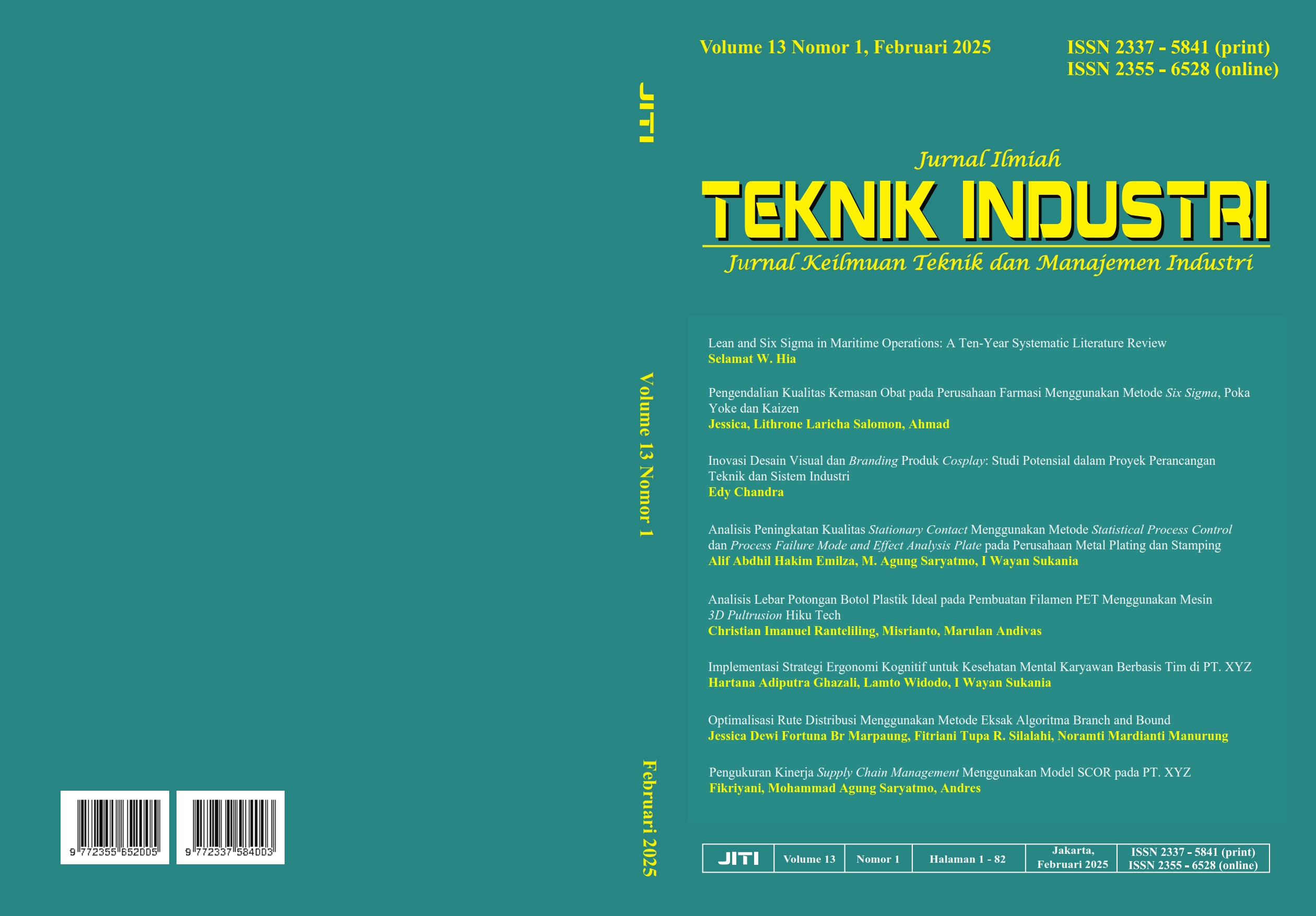INOVASI DESAIN VISUAL DAN BRANDING PRODUK COSPLAY: STUDI POTENSIAL DALAM PROYEK PERANCANGAN TEKNIK DAN SISTEM INDUSTRI
Main Article Content
Abstract
The creative industry is rapidly evolving, presenting product innovations that originate from visual ideas, one of which is cosplay product design. Currently, cosplay has become a major trend among Generation Z in Indonesia, as reflected in the dynamic growth of cosplay communities and events that stimulate the demand for creative products with strong visual identities. This study aims to analyze the potential for innovation in visual design and branding of cosplay products as a prospective study in engineering and industrial system design projects. A case study is conducted on the development of themed textile products by Cosplay Fabrics by Wyla, which translates creative visual concepts into industrial materials specifically designed for the cosplay community. The research method employs market needs analysis, visual design studies, and identification of branding strategies. The results show that cosplay products developed professionally with strong visual branding can enhance competitiveness, added value, and user loyalty. This study concludes that creative product objects such as cosplay hold significant potential to be adopted in engineering and industrial system design projects as a form of visual design-based innovation that is highly relevant to modern industrial development.
Article Details

This work is licensed under a Creative Commons Attribution-NonCommercial-ShareAlike 4.0 International License.

All publications by Jurnal Ilmiah Teknik Indsutri (Jurnal Keilmuan Teknik dan Manajemen Industri ) [p-ISSN: 2337-5841, e-ISSN: 2355-6528] is licensed under a Creative Commons Attribution-ShareAlike 4.0 International License.
References
[1] E. Chandra and N. D. Chandra, “Fenomenologi Personal Branding Cosplayer: Studi Desain Komunikasi Visual dan Media Sosial,” MAVIS J. Desain Komun. Vis., vol. 7, no. 01, pp. 51–59, 2025.
[2] “Cosplay Fabrics International – About Us.” 2024. [Online]. Available: https://www.cosplayfabricsinternational.com/pages/about-us
[3] A. Henderson, “From painters to pirates: A study of non-binary protagonists in young adult fiction,” Int. J. Young Adult Lit., vol. 3, no. 1, 2022.
[4] S. Jung and S. Lee, “Cosplay as a Fan Practice and Its Impact on the Cultural Industry,” Int. J. Cult. Stud., vol. 22, no. 3, pp. 381–397, 2019.
[5] D. Okabe, “Cosplay, Learning, and Cultural Production: Cross-cultural Perspectives BT - Fandom Unbound: Otaku Culture in a Connected World,” M. Ito, D. Okabe, and I. Tsuji, Eds. New Haven: Yale University Press, 2012.
[6] R. K. Yin, Case Study Research and Applications: Design and Methods. Thousand Oaks: SAGE Publications, 2018.
[7] “About COSPA: Company Profile.” 2025. [Online]. Available: https://www.cospa.com/staticdoc/p/company_aboutus
[8] TechTimes, “Cosplayer Yaya Han Partners With JOANN For New Fabric Line,” 2016. [Online]. Available: https://www.techtimes.com/articles/147791/20160404/cosplayer-yaya-han-partners-with-joann-for-new-fabric-line.htm
[9] V. Business, “How Cosplay Went Mainstream,” 2021. [Online]. Available: https://www.voguebusiness.com/consumers/how-cosplay-went-mainstream
[10] “Cosplay Fabrics Resources.” 2024. [Online]. Available: https://www.cosplayfabricsinternational.com/pages/resources
[11] “Cosplay Fabrics Gallery & Community.” 2024. [Online]. Available: https://www.cosplayfabricsinternational.com/pages/gallery
[12] C. Wirahata, W. Kosasih, and L. L. Salomon, “Penerapan Metode Kansei Engineering dan Quality Function Deployment (QFD) dalam Pengembangan Kualitas Produk Piama,” J. Ilm. Tek. Ind., vol. 11, no. 3, pp. 197–209, 2023.
[13] A. Insiders, “Indonesia’s Textile and Garment Sector is Growing with an Increasing Population and Greater Export Demand.” 2023. [Online]. Available: https://asianinsiders.com/2023/10/24/indonesias-textile-and-garment-sector-is-growing-with-an-increasing-population-and-greater-export-demand/
[14] S. West and K. Smith, “Eco-cosplay: upcycling as a sustainable method of costume construction,” Discov. Student J. Dale Bump. Coll. Agric. Food Life Sci., vol. 18, no. 1, pp. 90–98, 2017.
[15] S. H. Hengky, “Image analysis: textile industry in Indonesia,” World J. Bus. Manag., vol. 1, no. 1, pp. 42–56, 2015.
[16] S. Abbate, P. Centobelli, R. Cerchione, S. P. Nadeem, and E. Riccio, “Sustainability trends and gaps in the textile, apparel and fashion industries,” Environ. Dev. Sustain., vol. 26, no. 2, pp. 2837–2864, 2024.
[17] W. Handayaningrum and W. Suryandoko, “PENDIDIKAN SENI RUPA DI INDONESIA: SEJARAH, PERAN DAN TANTANGAN MASA DEPAN,” PRASI, vol. 18, no. 02, pp. 164–178, 2023.
[18] S. Putriningsih and D. Stiawan, “INOVASI DALAM FASHION MUSLIM SEBAGAI BAGIAN DARI EKONOMI KREATIF HALAL (Studi Kasus Rabbani Di Batang),” Sahmiyya J. Ekon. dan Bisnis, pp. 160–170, 2025.
[19] O. Novawanda and A. B. R. Indah, “ANALYSIS OF CONSUMER BEHAVIOR IN SHOPPING CHANNEL PREFERENCES IN A DUAL CHANNEL SUPPLY CHAIN STRUCTURE,” J. Ilm. Tek. Ind., vol. 12, no. 2, pp. 136–142, 2024.
[20] B. Harsanto, I. Primiana, V. Sarasi, and Y. Satyakti, “Sustainability innovation in the textile industry: a systematic review,” Sustainability, vol. 15, no. 2, p. 1549, 2023.
[21] V. Sarasi, I. Primiana, B. Harsanto, and Y. Satyakti, “Sustainable supply chain of Indonesia’s textile & apparel industry: opportunities and challenges,” Res. J. Text. Appar., vol. 28, no. 4, pp. 819–838, 2024.
[22] R. Rofaida, A. N. Aryanti, and Y. Perdana, “Strategi inovasi pada industri kreatif digital: Upaya memperoleh keunggulan bersaing pada era Revolusi Industri 4.0,” J. Manaj. Dan Keuang., vol. 8, no. 3, pp. 402–414, 2019.
[23] K. P. dan E. K. RI, “Siaran Pers: Nilai Tambah Ekonomi Kreatif Capai 55,65 Persen dari Target Tahun 2024.” 2024. [Online]. Available: https://kemenparekraf.go.id/berita/siaran-pers-nilai-tambah-ekonomi-kreatif-capai-5565-persen-dari-target-tahun-2024
[24] E. Chandra, B. Darmo, C. Leony, and V. Wilona, “Analisa Perkembangan Cosplay Pada Generasi Z Di Indonesia Sebagai Potensi Kurikulum Peminatan DKV: Studi Materi Pembelajaran Cosplay,” J. Vis., vol. 19, no. 2, 2024, doi: 10.24912/vis.v19i2.29176.
[25] L. Purwanitasari, Y. Wardani, A. Winarno, and W. P. Rahayu, “Tren Riset Keterkaitan Kreativitas sebagai Katalisator Inovasi Produk dan Kewirausahaan: Systematic Literature Review,” J. Ris. Multidisiplin Edukasi, vol. 2, no. 5, pp. 65–82, 2025.



